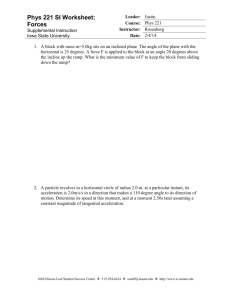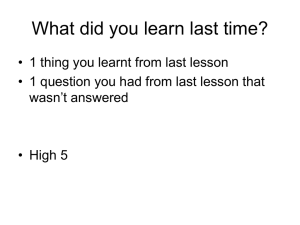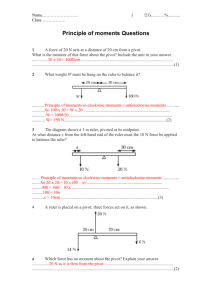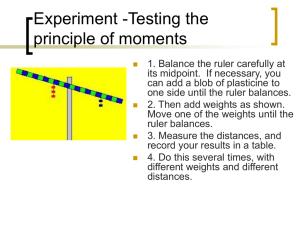L2 Forces
advertisement
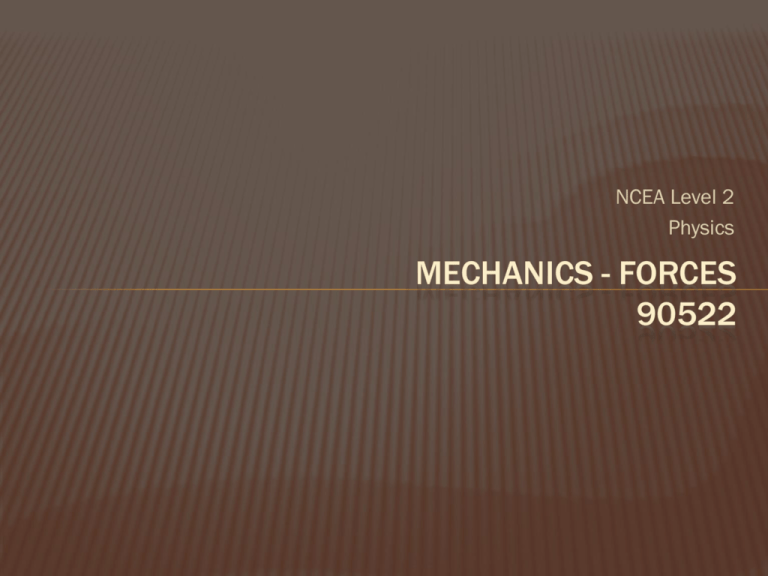
NCEA Level 2 Physics MECHANICS - FORCES 90522 MASS & WEIGHT What is the difference between mass & weight? MASS is the amount of substance we have and is measured in kg. This is a constant value wherever you go. WEIGHT is the force of gravity acting on the mass. This is measured in Newtons (N) and varies dependent on the planet you happen to be standing upon. The weight force can be calculated by: F = mg Where F = weight force (N) m = mass (kg) g = acceleration due to gravity. On Earth 9.81 ms-2 EXERCISE PAGE 52 RUTTER FORCE What is a force? A force is a vector that has both magnitude and direction. It can be made up of two or more forces that produce a resultant force. 5N 15N to the right 10N These force can act at angles and thus produce a resultant force which can be calculated using Pythagoras if a right angle triangle is formed. 10N ? 5N 5N 10N Calculate the force vector? EXERCISE PAGE 55 – 58 & PAGE 63 - 65 RUTTER NEWTONS 3 LAWS OF MOTION Sir Isaac Newton set up three laws of motion for macro particles: NEWTONS FIRST LAW “Every body continues in a state of rest or uniform motion in a straight line unless impressed forces act upon it.” AAAAAAAH STATE OF REST UNLESS ……. ! NEWTONS SECOND LAW “In order to change the motion of an object it must be accelerated. To accelerate an object force must be applied” This uses the following equation: F = ma Where F = weight force (N) m = mass (kg) a = acceleration (ms-2) Example 1: A 1.0kg mass is connected by a string to a trolley which has a mass of 3.0kg. What will the trolley’s acceleration be? a 3.0kg a (Take g = 10ms-2 and neglect friction in the axles of the trolley and the pulley.) 1.0kg Fw SOLUTION: The objects which accelerate are the 3.0kg trolley and the 1.0kg mass. Acceleration of trolley = acceleration of mass + trolley: a = F/m Total mass of objects = 4.0kg = 10/4.0 Force causing acceleration is Fw: = 2.5ms-2 Fw = mg = 1.0 x 10 Fw = 10N NEWTONS THIRD LAW “Forces occur in pairs. So for every action there is an equal and opposite reaction” THE CLUB EXERTS A FORCE F ON THE BALL THE BALL EXERTS AN EQUAL AND OPPOSITE FORCE F ON THE CLUB F Newton's Third Law. The rocket's action is to push down on the ground with the force of its powerful engines, and the reaction is that the ground pushes the rocket upwards with an equal force. EXERCISE PAGE 53 - 55 RUTTER FRICTION & TENSION FRICTION Produced when two surfaces come into contact and ‘grip’ together without slipping past each other. One surface slide over another. Friction always opposes the relative motion of an object. Must be allowed for when involved in the situation. Usually friction is subtracted from the applied force to give a resultant. Fres = F - Ffriction N.B: In vector notation the negative shows acting in the opposite direction. Example 2: The thrust from the outboard motor of a powerboat is 1000N. If the boat has a mass of 500kg and the friction force opposing the motion of the boat through the water is 200N, what is the power boat’s acceleration? 1000N SOLUTION: The resultant force on the powerboat is: Fres = 1000 – 200 = 800N (forward) Using Fres = ma, the acceleration is: a = Fres/m a = 800/500 a = 1.6ms-1 200N Fres TENSION This is a force found in connections and strings. It pulls in both directions along the string or rope. A stationary 0.5kg mass hangs on the end of a string from a ceiling. Tension is caused in the string by the weight force (5N) of the hanging mass. Tension acts downward on the ceiling due to the weight force of the mass. The tension also acts upward on the hanging mass to balance the weight force acting down. The effect on the string is that tension acts to pull the string apart. If the string is not strong enough then it will snap! Ceiling reaction F String Tension 5.0N Tension 5.0N 0.5kg Weight 5.0N Example 3: Two masses of 1.0kg and 2.0kg are suspended by strings. Calculate the size of the tensions in the strings shown in the diagram alongside. SOLUTION: Ceiling Free body force diagrams can be drawn to show forces acting on each mass. Tension 2 The forces acting on the 1.0kg mass are shown: 2.0kg Tension 1 Fw = mg Fw = 1.0 x 10 1.0kg Fw = 10N Fw = 10N Thus tension 1 = 10N Tension 1 1.0kg Weight Fw The forces acting on the 2.0kg mass are shown alongside – the weight force of the 2.0kg mass is: Tension 2 Fw = 2.0 x 10 Fw = 20N and so the total force acting downwards is: 2.0kg Tension 1 Fw 20 + 10 = 30N. Thus tension 2 must be 30N to balance the forces upwards. Fw = 2.0 x 10 = 20N EXERCISE PAGE 55 - 58 RUTTER TORQUE Often the force required to get an object to change its velocity either a. Can not applied straight on an object. b. Is too great a force that a person is unable to exert it. In this case a tool has to be required. E.g. a spanner on a bolt. In this case the force is applied further away from the object and produces a turning force or torque (). The turning force is directly related to the force applied and the distance it is applied from the pivot point. Hence the equation: = Fd Where = torque, turning force(Nm) F = Force (N) d = distance from pivot (m) Example 4: A force of 10N which acts at 8.0cm from the pivot is needed to lift the cap off a bottle of soft drink. Calculate the torque: SOLUTION: =Fxd 10N = 10 x 0.080 8.0cm = 0.80 Nm anticlockwise This torque is the same as a force of 40 N acting 2.0 cm from the pivot. EXERCISE PAGE 58 RUTTER TORQUE & EQUILIBRIUM COUPLES: This where two equal and oppositely directed forces act at a distance apart. A couple causes rotation. The diagram shows the situation of a couple applied to a jam jar lid. The torque produced by the couple is caused by two equally sized forces. The size of the torque is: SOLUTION: = (F x d/2) + (F x d/2) = Fd F d F PRINCIPLES BEHIND TORQUE: Pivot point 1 2 1 1 = 2 2 1 = 2 FOR A SYSTEM TO BE IN EQUILIBRIUM, THE SUM OF THE CLOCKWISE TORQUE ABOUT ANY POINT MUST EQUAL THE SUM OF THE ANTICLOCKWISE TORQUE ABOUT THAT POINT EQUILIBRIUM is when either: 1. The resultant force or vector sum of the forces equals zero. 2. The sum of all torques acting on the object is zero. Often torque can be replaced with the word moments Anticlockwise torque Clockwise torque Anticlockwise Torque = 8.0N x 0.03m =0.24 Nm Calculate the anticlockwise and clockwise torque Clockwise Torque = 6.0N x 0.04m =0.24 Nm THE SYSTEM IS IN EQUILIBRIUM Example 5: A metre ruler of negligible mass is pivoted at P, at the 20cm mark. A mass weighing 15N is suspended from the 80cm mark. What weight, Fw, must be suspended at the 10cm mark so that the metre ruler is balanced? 0.20m 0.10m 0.80m P Fw 0.0m 15N 1.0m SOLUTION: For the ruler to be balanced, the sum of clockwise moments must equal the sum of anticlockwise moments. Taking moments about pivot point, P: Clockwise moments = Fd = 15 x (0.80 - 0.20) = 15 x 0.60 = 9.0Nm Anticlockwise moments = Fd = Fw(0.20 – 0.10) = 0.10 x Fw Nm Since sum of clockwise moments = sum of anticlockwise moments: 9.0 = 0.10Fw Fw = 90N The two weights add to give a total force of 105N (90 + 15) acting downward on the pivot. There must also be a reaction force of 105N upward on the metre ruler at the pivot. Overall, the forces acting on the metre ruler are 105N upward and 105N downward so that the metre ruler is in euilibrium. The weight of an object acts down through the object’s centre of mass. This is the point at which, if an object is suspended or pivoted, the object will balance. Centre of mass Centre of mass of the ruler is the point in the middle of the ruler. weight Example 6: A house painter uses a uniform wooden plank 2.00m long and of weight 300N. It is supported at both ends by trestles A and B. The painter (of weight 800N) stands 0.50m from trestle A. Calculate the size of the forces with which trestles A and B hold up the plank and painter. 1.00m FA FB 0.50m 0.0m 2.0m A B 300N 800N SOLUTION: The diagram is drawn with the weight force of the plank (acting through the centre of mass), the reaction forces on the trestles (FA and FB), and the painter’s weight force. To find the size of the force on pivot B (F B), moments are taken about pivot A. At this point, FA produces no torque, since it acts through A. Clockwise moments = (800 x 0.50) + (300 x 1.00) = 400 + 300 = 700 Nm Anticlockwise moments = FB x 2.00 Clockwise moments 700 = Anticlockwise moments = 2.00 FB FB = 350N FA can be calculated by considering the other condition for equilibrium; ie the vector sum of forces = 0. Sum of forces upward = sum of forces downward FA + FB = 800 + 300 FA + 350 = 1100 FA = 750 N The calculation could be checked by taking the moments about pivot B. It would not help to take moments about the centre of the plank or the painter, since both FA and FB would be present together in the one equation of moments. EXERCISE PAGE 59 - 60 RUTTER BRAIN TEASER Determine the mass of a retort stand using a 500g mass, a ruler, and a laboratory stool as a pivot. STEP ONE Turn the laboratory stool upside down and slide the retort stand shaft along one of the metal braces until the retort stand balances. The point along the retort stand shaft above the pivot is the centre of mass for the retort stand. Mark its position carefully STEP TWO Hang the 500g at the top of the retort stand shaft and rebalance the retort stand. Measure the distance of the centre of mass to the new pivot position and the distance from the 500g mass to the new pivot position. STEP THREE Calculate the weight of the retort stand from the measurements taken using equilibrium of moments. A B Retort stand Weight of retort stand 5.0N Anticlockwise moment = clockwise moment Weight of retort stand x A = 5.0 x B Mass of the retort stand can be determined from W = mg CIRCULAR MOTION In order to keep an object in a circular motion a force has to applied to an object. This force is called centripetal force and act to the centre of the circle being produced. The effect of this force is that the direction changes and thus the object accelerates. F = ma We know from previous work the acceleration is called centripetal acceleration and also acts to the centre of the circle being produced. We know that: ac = v2/r Substituting into: F = ma v Fc & ac We can calculate Fc by: Fc = mv2/r EXERCISE PAGE 65 66 RUTTER Practical: Investigating ‘F’ and Time Period in circular motion (Page 68 Rutter) SPRINGS & HOOKES LAW Forces can also be used to extend strings. Study was done into this by Robert Hooke who was a 17th Century British Physicist. He stated that: “the amount by which a material body is deformed (the strain) is linearly related to the force causing the deformation (the stress)” From this he stated in 1678 the following: “as the extension increases so does the force” From this he stated mathematically: Where F = restoring force (N) x = extension (m) k = spring constant (Nm-1) Fx This is converted to: F = -k x k is written as a negative shows the direction. On a graph the rules change in that the independent variable ‘F’ goes up the y-axis and the dependent variable ‘x’ goes a long the x-axis. F (N) k = gradient k is a constant and really is the degree of “stretch-ability” a spring has when a force is applied x (m) Practical: To Investigate Hookes law (Page 67 Rutter) EXERCISE PAGE 65 - 66 RUTTER

